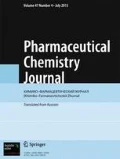Computer modelling methods based on “structure-property” relationships (QSPR) allows rational planning of both experimental studies and the effective generation of structures with the ability to cross the blood-brain barrier (BBB). The aim of this work was to create a “structure-property” model based on the simplex presentation of molecules for non-experimental assessment of their ability to cross the BBB and to carry out structural interpretation of the model, taking account of the mutual influences of atoms in the molecule. The simplex method for representing molecular structures was used to evaluate the contributions of different molecular fragments and functional groups to the level of neuroavailability of compounds diffusing across the BBB. The presence of strongly polar and ionogenic groups (carboxyl, carbonyl, phenol hydroxyl) was found to have adverse effects on the ability of substances to penetrate into the brain. The presence of halogen atoms and aromatic fragments had positive influences on transfer of substances through the BBB. The QSPR model constructed here was characterized by satisfactory predictive accuracy as assessed using the RandomForest internal model validation procedure (R2 = 0.54; RMSE = 0.47).


Similar content being viewed by others
References
O. A. Raevskii, S. L. Solodova, O. E. Raevskaya, et al., Biomed. Khimiya, No. 3, 246 – 256 (2012).
O. A. Raevskii, S. L. Solodova, O. E. Raevskaya, and R. Mankhol’d, Khim-Farm. Zh., 46(3), 3 – 8 (2012); Pharm. Chem. J., 46(3), 133 – 138 (2012).
V. E. Kuz’min, A. G. Artemenko, P. G. Polischuk, et al., Mol. Modelling, No. 11, 457 – 467 (2005).
W. L. Jolly and W. B. Perry, J. Am. Chem. Soc., 95(17), 5442 – 5450 (1973).
R. Wang, Y. Fu and L. Lai, J. Chem. Inform. Computer Sci., 37(3), 615 – 621 (1997).
B. V. Ioffe, Refractometric Methods in Chemistry [in Russian], Khimiya, Leningrad (1983).
L. Breiman, Random Forests, 45, No. 1, 5 – 32 (2001).
R: A Language and Environment for Statistical Computing, R Foundation for Statistical Computing, Vienna, Austria (2012), 1731.
N. A. Kovdienko, P. G. Polishchuk, N. E. Muratov, et al., Molec. Inform., 29(5), 394 – 406 (2010).
A. G. Artemenko, V. E. Kuz’min, E. N. Muratov, et al., Khim-Farm. Zh., 43(8), 27 – 35 (2009); Pharm. Chem. J., 43(8), 454 – 462 (2009).
P. G. Polishchuk, V. E. Kuz’min, A. G. Artemenko, and E. N. Muratov, Molec. Inform., 32(9 – 10), 843 – 853 (2013).
M. H. Abraham, A. Ibrahim, et al., J. Pharmaceut. Sci., 95, No. 10, 2091 – 2100 (2006).
P. Garg and J. Verma, J. Chem. Inform. Model., 46(1), 289 – 297 (2005).
A. Guerra, J. A. Páez, and N. E. Campillo, QSAR Combinatorial Sci., 27(5), 586 – 594 (2008).
J. Kelder, P. D. Grootenhuis, D. M. Bayada, et al., Pharmaceut. Res., 16(10), 1514 – 1519 (1999).
D. A. Konovalov, D. Coomans, E. Deconinck, and Y. V. Heyden, J. Chem. Inform. Modeling., 47(4), 1648 – 1656 (2007).
S. R. Mente and F. Lombardo, J. Computer-Aided Molec. Design, 19(7), 465 – 481 (2005).
R. Narayanan and S. B. Gunturi, Bioorgan. Med. Chem., 13(8), 3017 – 3028 (2005).
J. A. Platts, M. H. Abraham, Y. H. Zhao, et al., Eur. J. Med. Chem., 36(9), 719 – 730 (2001).
R. C. Young, R. C. Mitchell, T. H. Brown, et al., J. Med. Chem., 39, 656 – 671 (1988).
M. H. Abraham, H. S. Chadha, and R. C. Mitchell, J. Pharm. Sci., 83, 1257 – 1268 (1994).
J. A. Gratton, M. H. Abraham, Bradbury, et al., J. Pharm. Pharmacol., 49, 1211 – 1216 (1997).
Author information
Authors and Affiliations
Additional information
Translated from Khimiko-Farmatsevticheskii Zhurnal, Vol. 51, No. 1, pp. 35 – 38, January, 2017.
Rights and permissions
About this article
Cite this article
Polishchuk, P.G., Kosinskaya, A.P., Larionov, V.B. et al. A Ranged Series of Drug Molecule Fragments Defining Their Neuroavailability. Pharm Chem J 51, 35–38 (2017). https://doi.org/10.1007/s11094-017-1553-z
Received:
Published:
Issue Date:
DOI: https://doi.org/10.1007/s11094-017-1553-z




